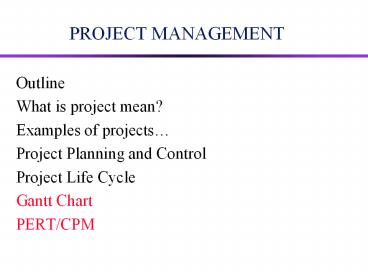PROJECT MANAGEMENT PowerPoint PPT Presentation
Title: PROJECT MANAGEMENT
1
PROJECT MANAGEMENT
- Outline
- What is project mean?
- Examples of projects
- Project Planning and Control
- Project Life Cycle
- Gantt Chart
- PERT/CPM
2
What is Project?
- What is the different between normal business
activities and Project? - Project
- Unique, one time operations design to
accomplish a specific set of objectives in a
limited time frame.
3
Examples of project
- Building a house
- Building a factory
- Add assembly line in the factory
- Merging to companies
- Managing political campaign
- Designing a new product
- Soft ware development
4
Work Breakdown Structure
5
- What are the tools?
- Work breakdown structure
- Network diagram
- Gantt charts
- Risk management
6
Key Decisions
- Deciding which projects to implement
- Selecting a project manager
- Selecting a project team
- Planning and designing the project
- Managing and controlling project resources
- Deciding if and when a project should be
terminated
7
Project Manager Responsibility
Work Quality Human Resources Time Communica
tions Costs
8
Project Control Gantt Chart
a
b
a
c
b
d
c
d
d
9
PERT and CPM
- PERT Program Evaluation and Review Technique
- CPM Critical Path Method
- Graphically displays project activities
- Estimates how long the project will take
- Indicates most critical activities
- Show where delays will not affect project
10
The Network Diagram
- Network (precedence) diagram diagram of project
activities that shows sequential relationships by
the use of arrows and nodes. - Activity-on-arrow (AOA) a network diagram
convention in which arrows designate activities. - Activity-on-node (AON) a network diagram
convention in which nodes designate activities. - Activities steps in the project that consume
resources and/or time. - Events the starting and finishing of
activities, designated by nodes in the AOA
convention.
11
The Network Diagram (contd)
- Path
- Sequence of activities that leads from the
starting node to the finishing node - Critical path
- The longest path determines expected project
duration - Critical activities
- Activities on the critical path
- Slack
- Allowable slippage for path the difference the
length of path and the length of critical path
12
Project Network Activity on Arrow
Figure 17.4
AOA
13
Project Network Activity on Node
Figure 17.4
AON
14
Network Conventions
15
Questions answered by PERT/CPM
- When will the entire project be completed?
- What are the critical activities or tasks in the
project, that is, the ones that will delay the
entire project if they are late? - Which are the non-critical activities, that is,
the ones that can run late without delaying the
entire projects completion? - What is the probability that the project will be
completed by a specific date?
16
Questions answered by PERT/CPM
- At any particular date, is the project on
schedule, behind schedule, or ahead of schedule? - On any given date, is the money spent equal to,
less than, or greater than the budgeted amount? - Are there enough resources available to finish
the project on time? - If the project is to be finished in a shorter
amount of time, what is the best way to
accomplish this at the least cost?
17
To Find Critical Path ???
- To find the critical path, need to determine the
following quantities for each activity in the
network - 1. Earliest start time (ES) the earliest time an
activity can begin without violation of immediate
predecessor requirements. - 2. Earliest finish time (EF) the earliest time
at which an activity can end. - 3. Latest start time (LS) the latest time an
activity can begin without delaying the entire
project. - 4. Latest finish time (LF) the latest time an
activity can end without delaying the entire
project.
18
CPM with Three Activity Time Estimates
19
Expected Times

